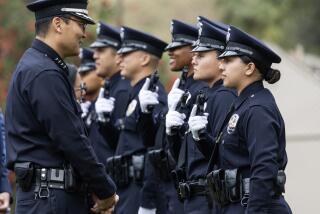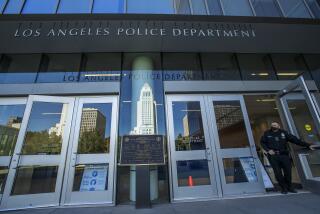Don’t Multiply the Mixed Messages : Reform creates its own conflicts. Leaders and the community must help police be able to weather those new storms.
What the Christopher Commission has documented in the Los Angeles Police Department is deplorable but, sadly, not unusual in many American cities. Racist, sexist, brutish talk and behavior blemish agencies everywhere and, almost always, steal the spotlight from the far more pervasive courage, caring and helpfulness of American police.
As Los Angeles and communities elsewhere rededicate themselves to minimizing excessive force by police, what are some of the considerations they need to keep in mind to prevent their efforts from backfiring or simply producing fleeting adjustments in business as usual?
Reformers must be realistic and candid about possible trade-offs between control of police violence and incentives to make arrests. In controlling police use of deadly force (shootings), a certain number of shootings by police can be curtailed without exposing officers to greater dangers, increasing the level of crime or diminishing arrest incentives. But the available research (hardly sufficient) suggests that police aggressiveness in making legitimate arrests tends to decrease somewhat after administrative initiatives are undertaken to reduce non-lethal brutality.
Controlling brutality is essential, but failure to acknowledge the trade-offs can perpetuate the kind of mixed messages to cops (“show restraint” . . . “don’t tell me how you do it, just reduce crime”) that often exacerbate brutality problems. This trade-off may not be inevitable, as the Christopher Commission implies by directing the nation’s attention to the movement toward “community policing” and “problem-oriented policing”--strategic approaches that operate from the premise that one can be tough on crime by being warm on communities.
Stereotyping LAPD officers--just as some officers stereotyped citizens and other officers in derogatory computer communications--will demoralize them, a result that cannot be dismissed with the bromide that vilification is an occupational hazard. Progressive police trainers report that giving new officers the confidence and courage to use force decisively and skillfully when called for is a problem as difficult as controlling abusive police.
Elected officials need political courage today to forge significant organizational changes in police agencies and courage tomorrow to help the LAPD withstand the sometimes politically sensitive consequences of reform. If the department reverses its apparent discouragement of citizens’ complaints, it could see a dramatic, chamber of commerce-jolting increase in allegations of police abuse.
During the period 1986-1990, the Chicago Police Department, which is considerably more open to accepting citizen complaints, had five times the number of allegations of police brutality as the LAPD (11,157 versus 2,152). Even correcting for the difference in department sizes, Chicago officers were more than three times as likely as LAPD personnel to be accused of brutality and were more than 10 times as likely to have those allegations sustained by the department. Today’s LAPD critics will need to vocalize their support for appropriate organizational house-cleaning but object strenuously to scapegoating of officers as an easy alternative to correcting structural deficiencies.
We have to be careful not to set up minority or women officers with excessive demands to “sensitize” a discriminatory organization, by their very presence, in the short term. The pressures to conform to organizational culture are awesome in police organizations, where alienation from colleagues can spell death in the gutter.
Moreover, we have to understand the position we place minority officers in when, for community-relations reasons, we disproportionately assign them to high-crime (and typically predominantly minority) neighborhoods: In many jurisdictions, minority officers are disproportionately likely to use their firearms against suspects and to be shot by them.
In the anxiety to reform rapidly, care must be taken that recommended changes and their implementation do not work at cross purposes. For instance, the commission’s call for regular rotation of officers’ assignments around the city may be in conflict with its call for adoption of a community-policing model, in which a great premium is placed on long-term assignments that allow rapport between officers and residents to grow.
It is important as well to conduct far more penetrating comparisons between the LAPD and other departments than was possible for the Christopher Commission. For example, reformers might benefit from exploring why, despite its apparent reputation for quick resort to firearms, the LAPD actually has a lower rate of shootings by officers (based on the frequency of arrests for violent felonies) than many other large cities. Similarly, it is crucial not to accept uncritically portraits of the skyrocketing dangers of American police work. Based on exposure to potential hazard (as measured by violent felony arrests), American police on average are 300% less likely to be killed feloniously in the line of duty today than they were in the mid-1970s; and, by the same measure, they are 150% less likely to be assaulted (with or without injury) by assailants armed with deadly weapons.
Finally, the unfortunate commonality across America of many of the police problems surfaced by the Christopher Commission suggests than reformers must have a healthy appreciation of the time, dedication and resources that meaningful progress will require.
The commission took 100 days to map some ambitious plans. To carry them out successfully will require the kind of collective will and reordering of priorities that was represented, in a different context, by the nation’s recent 100-day campaign in the Persian Gulf.
Police Shootings
Persons shot fatally or non-fatally by police per 1,000 arrests for violent felonies (murder and non-negligent manslaughter, forcible rape, aggravated assault and robbery):
Atlanta: 2.8
Chicago: 3.2
Dallas: 4.0
Kansas City (MO): 2.5
Los Angeles: 2.5
New York: 1.6
Philadelphia: 3.3
St. Louis: 1.9
Source: William A. Geller, Police Executive Research Forum
More to Read
Sign up for Essential California
The most important California stories and recommendations in your inbox every morning.
You may occasionally receive promotional content from the Los Angeles Times.










